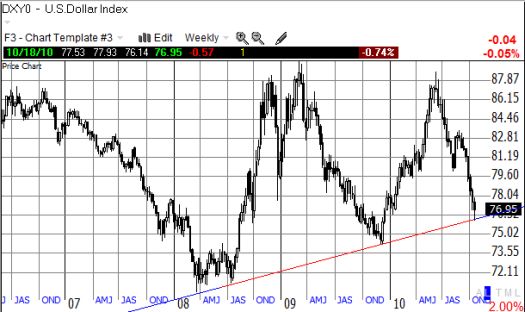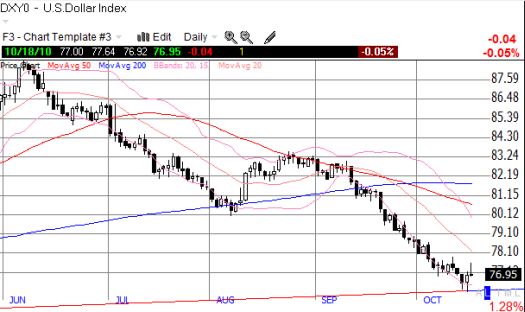Since peaking in June, the dollar has arguably experienced a near freefall. These moves reflect the near certainty felt amongst investors and traders about the Federal Reserve’s intention to print more currency to forestall the threat of deflation. However, with dollar shorts at their highest levels in three years and the dollar index stalling at the next support level, it is time to look out for a potential relief rally.
Assuming the dollar short has become an extremely crowded trade, it will only take a little dose of uncertainty in the dollar’s weakness to motivate traders to lock in profits and/or dissuade new sellers from joining the party (if any new sellers remain). Over the last few days, the market has absorbed statements from Ben Bernanke and U.S. Treasury Secretary Timothy Geithner that could generate a few doses of uncertainty about the dollar’s weakness.
On Friday, Bernanke gave a speech titled “Monetary Policy Objectives and Tools in a Low-Inflation Environment” where he laid out the Federal Reserve’s tentative plans for attacking the risks of deflation. While overall it seems the Fed is ready to dig in its heels on this fight and do whatever it thinks is necessary, Bernanke admitted to limits of the Fed’s effectiveness, to a high level of uncertainty regarding outcomes, and to the very real risks of unknown costs for taking anti-deflationary action. Here are some key quotes (emphasis mine):
“Although attaining the long-run sustainable rate of unemployment and achieving the mandate-consistent rate of inflation are both key objectives of monetary policy, the two objectives are somewhat different in nature. Most importantly, whereas monetary policymakers clearly have the ability to determine the inflation rate in the long run, they have little or no control over the longer-run sustainable unemployment rate, which is primarily determined by demographic and structural factors, not by monetary policy. Thus, while central bankers can choose the value of inflation they wish to target, the sustainable unemployment rate can only be estimated, and is subject to substantial uncertainty…
…Given the Committee’s objectives, there would appear–all else being equal–to be a case for further action. However, as I indicated earlier, one of the implications of a low-inflation environment is that policy is more likely to be constrained by the fact that nominal interest rates cannot be reduced below zero. Indeed, the Federal Reserve reduced its target for the federal funds rate to a range of 0 to 25 basis points almost two years ago, in December 2008. Further policy accommodation is certainly possible even with the overnight interest rate at zero, but nonconventional policies have costs and limitations that must be taken into account in judging whether and how aggressively they should be used…
…However, possible costs must be weighed against the potential benefits of nonconventional policies. One disadvantage of asset purchases relative to conventional monetary policy is that we have much less experience in judging the economic effects of this policy instrument, which makes it challenging to determine the appropriate quantity and pace of purchases and to communicate this policy response to the public. These factors have dictated that the FOMC proceed with some caution in deciding whether to engage in further purchases of longer-term securities.
Another concern associated with additional securities purchases is that substantial further expansion of the balance sheet could reduce public confidence in the Fed’s ability to execute a smooth exit from its accommodative policies at the appropriate time. Even if unjustified, such a reduction in confidence might lead to an undesired increase in inflation expectations, to a level above the Committee’s inflation objective. To address such concerns and to ensure that it can withdraw monetary accommodation smoothly at the appropriate time, the Federal Reserve has developed an array of new tools. With these tools in hand, I am confident that the FOMC will be able to tighten monetary conditions when warranted, even if the balance sheet remains considerably larger than normal at that time.”
Bernanke is so concerned with the Fed’s ability to execute anti-deflationary policy that he openly signaled the Fed might try a heavy dose of extra jawboning to tease inflation back up toward the Fed’s target:
“A step the Committee could consider, if conditions called for it, would be to modify the language of the statement in some way that indicates that the Committee expects to keep the target for the federal funds rate low for longer than markets expect.”
In other words, whatever type of QE unfolds starting in November, it is likely to be a “cautious QE.” It will not likely be the kind of full sprint that would cause the dollar to drive to zero overnight. Bernanke is even claiming that the Fed will remain mindful of the potential adverse consequences of its actions. While I remain dubious that the Federal Reserve will be able to tighten when needed, I am very intrigued to hear the Chairman even mention tightening in the same breath he uses to lay out a plan for further easing of policy. Overall, these are ingredients that should give the most aggressive dollar shorts some pause and motivate at least the marginal positions to close up shop as they pullback to “wait and see” and re-evaluate the potential pace for the dollar’s future weakness.
Timothy Geithner really threw me for a loop – so much so, that I am still incredulous. But I still offer up his claims because they were noteworthy and thus represent information that the market may internalize. On Monday, Geithner spoke at the latest meeting of The Commonwealth Club of California and reassured the audience that:
“It is very important for people to understand that the United States of America and no country around the world can devalue its way to prosperity, to [be] competitive…It is not a viable, feasible strategy and we will not engage in it…[the United States needs to] work hard to preserve confidence in the strong dollar.”
This went a little beyond the obligatory “strong dollar policy” reiterated in ever so unconvincing fashion by Geithner and his predecessors over the many years. So, the statement deserves some reflection and, again, provides a potential catalyst for marginal dollar shorts to exit and begin a dollar relief rally.
Regardless of whether one believes Bernanke or Geithner or thier chances for success in executing their stated policy positions, the implications of these words should be respected in an environment in which the dollar has been in near freefall. If a relief rally unfolds, there will be a good chance that the dollar index will not retest current support for some time to come. Moreover, the euro is signaling some confirming evidence by its struggle to break and hold the 1.40 level against the U.S. dollar (the euro is a little over 50% of the dollar index).
Here are the weekly and daily charts of the dollar index to show how it has successfully tested the next level of support, an upward trendline from the 2008 lows. As with all technical levels of importance, a break of this support will put even lower levels into play.


*All charts created using TeleChart:

(Brian Kelley, Fast Money contributor, takes the contrarian argument to the extreme by claiming that QE II will be good for the dollar. I am NOT going that far. For example, I am sticking with my long Australian dollar position against the U.S. dollar. I am bearish the euro and not bullish the dollar.)
Be careful out there!
Full disclosure: short EUR/USD, long FXA
